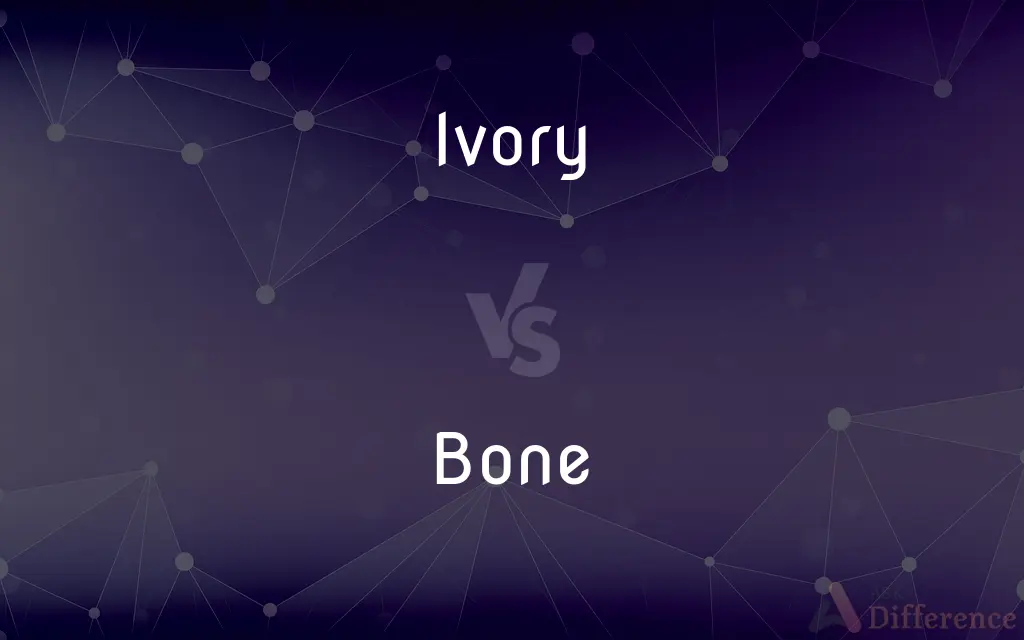Ivory vs. Bone — What's the Difference?
By Fiza Rafique & Urooj Arif — Updated on March 20, 2024
Ivory, a dense material from animal tusks and teeth, is known for its smooth texture and value in art, whereas bone, a common skeletal tissue, supports structure and function in vertebrates.

Difference Between Ivory and Bone
Table of Contents
ADVERTISEMENT
Key Differences
Ivory is a specialized material that comes from the tusks and teeth of animals such as elephants, walruses, and narwhals. It has been highly valued in art and craftsmanship for centuries, known for its smooth texture, fine grain, and ability to be carved into intricate designs. Bone, on the other hand, is a common structural component found in the skeletons of vertebrate animals, including humans, serving as the framework for the body and playing essential roles in support, protection, and movement.
The composition of ivory includes a high concentration of dentin, a calcified tissue that is denser and harder than bone, which is made up of a matrix of collagen fibers and mineral deposits. This gives ivory its characteristic smoothness and durability, making it suitable for detailed carvings, while bones are more porous and less suitable for fine artistry.
Ivory has historically been used in luxury items and artworks, such as piano keys, decorative items, and religious artifacts, reflecting its aesthetic appeal and cultural significance. Bone, while also used in tools, jewelry, and decorative items throughout history, is more widely recognized for its biological functions, including mineral storage and the production of blood cells within bone marrow.
The trade and use of ivory have become highly controversial due to the threat it poses to endangered species, leading to strict regulations and an international ban on ivory trade to protect animals like elephants. Bone, particularly from domesticated animals, does not face the same ethical concerns and remains in use for various applications, including culinary, musical, and artistic.
Understanding the differences between ivory and bone is crucial not only for appreciating their unique properties and uses but also for recognizing the ethical implications of ivory use and the need for conservation efforts to protect wildlife.
ADVERTISEMENT
Comparison Chart
Source
Tusks and teeth of certain mammals
Skeletal structures of vertebrates
Composition
High concentration of dentin
Collagen fibers and mineral deposits
Texture
Smooth, dense, and fine-grained
Porous and rougher
Primary Use
Art, luxury items, and craftsmanship
Structural support, mineral storage
Cultural Significance
Valued in art and luxury items
Used in tools, jewelry, and everyday items
Ethical Concerns
Endangered species protection, trade bans
Generally fewer concerns, except for human remains
Compare with Definitions
Ivory
Known for its fine grain and polish.
Ivory's smooth texture makes it ideal for intricate carvings.
Bone
Forms the framework of vertebrate bodies.
Bone structures are crucial for movement and protection.
Ivory
Used in fine art and high-value items.
The antique chess set was carved from pure ivory.
Bone
Involved in blood cell production.
The bone marrow is a key site for producing blood cells.
Ivory
Comes from at-risk animals.
Elephant tusks, the primary source of ivory, are heavily regulated.
Bone
Employed in tools and ornaments.
Historically, bones were fashioned into tools and jewelry.
Ivory
Highly prized in craftsmanship.
Master artisans often preferred ivory for its workability and finish.
Bone
More readily available than ivory.
Bone, being a by-product of meat consumption, is easier to obtain.
Ivory
Primarily consists of dentin.
The density of ivory lends it a substantial, quality feel.
Bone
Less controversial than ivory.
Using animal bones raises fewer ethical issues compared to ivory.
Ivory
Ivory is a hard, white material from the tusks (traditionally from elephants) and teeth of animals, that consists mainly of dentine, one of the physical structures of teeth and tusks. The chemical structure of the teeth and tusks of mammals is the same, regardless of the species of origin.
Bone
Former name for Annaba
Ivory
A hard creamy-white substance composing the main part of the tusks of an elephant, walrus, or narwhal, often (especially formerly) used to make ornaments and other articles
A dagger with an ivory handle
Bone
Remove the bones from (meat or fish) before cooking, serving, or selling
Ask your butcher to bone the turkey for you
Ivory
The creamy-white colour of ivory
An ivory silk blouse
Bone
Study (a subject) intensively, typically in preparation for something
She boned up on languages she had learned long ago
Ivory
A hard, smooth, yellowish-white substance composed primarily of dentin that forms the tusks of the elephant.
Bone
The dense, semirigid, porous, calcified connective tissue forming the major portion of the skeleton of most vertebrates. It consists of a dense organic matrix and an inorganic, mineral component.
Ivory
A similar substance forming the tusks or teeth of certain other mammals, such as the walrus.
Bone
Any of numerous anatomically distinct structures making up the skeleton of a vertebrate animal. There are more than 200 different bones in the human body.
Ivory
A tusk, especially an elephant's tusk.
Bone
A piece of bone.
Ivory
An article made of ivory.
Bone
The skeleton.
Ivory
A substance resembling ivory.
Bone
The body
These old bones don't do much dancing anymore.
Ivory
A pale or grayish yellow to yellowish white.
Bone
Mortal remains
His bones are buried up on the hill.
Ivory
(Music) Piano keys.
Bone
An animal structure or material, such as ivory, resembling bone.
Ivory
(Games) Dice.
Bone
A piece of whalebone or similar material used as a corset stay.
Ivory
(Slang) The teeth.
Bone
Bones(Informal) Dice.
Ivory
Composed or constructed of ivory.
Bone
Bones The fundamental plan or design, as of the plot of a book.
Ivory
Of a pale or grayish yellow to yellowish white.
Bone
Bones Flat clappers made of bone or wood originally used by the end man in a minstrel show.
Ivory
(uncountable) The hard white form of dentin which forms the tusks of elephants, walruses and other animals.
Bone
Bones (used with a sing. verb) The end man in a minstrel show.
Ivory
A creamy white color, the color of ivory.
Bone
Vulgar Slang The penis.
Ivory
Something made from or resembling ivory.
Bone
To remove the bones from
Bone a fish.
Ivory
The teeth.
Bone
To stiffen (a piece of clothing) with stays, as of whalebone.
Ivory
The keys of a piano.
To tickle the ivories
Bone
(uncountable) A composite material consisting largely of calcium phosphate and collagen and making up the skeleton of most vertebrates.
Ivory
(slang) A white person.
Bone
(countable) Any of the components of an endoskeleton, made of bone.
Ivory
(informal) A die object bearing numbers, thrown in games of chance.
Bone
A bone of a fish; a fishbone.
Ivory
Made of ivory.
Bone
A bonefish.
Ivory
Resembling or having the colour of ivory.
Bone
One of the rigid parts of a corset that forms its frame, the boning, originally made of whalebone.
Ivory
The hard, white, opaque, fine-grained substance constituting the tusks of the elephant. It is a variety of dentine, characterized by the minuteness and close arrangement of the tubes, as also by their double flexure. It is used in manufacturing articles of ornament or utility.
Bone
One of the fragments of bone held between the fingers of the hand and rattled together to keep time to music.
Ivory
The tusks themselves of the elephant, etc.
Bone
Anything made of bone, such as a bobbin for weaving bone lace.
Ivory
Any carving executed in ivory.
Bone
(figurative) The framework of anything.
Ivory
Teeth; as, to show one's ivories.
Bone
An off-white colour, like the colour of bone.
Ivory
A hard smooth ivory colored dentine that makes up most of the tusks of elephants and walruses
Bone
A dollar.
Ivory
A shade of white the color of bleached bones
Bone
The wishbone formation.
Bone
(slang) An erect penis; a boner.
Bone
A domino or dice.
Bone
(slang) A cannabis cigarette; a joint.
Bone
(figurative) A reward.
Bone
(slang) trombone
Bone
Of an off-white colour, like the colour of bone.
Bone
To prepare (meat, etc) by removing the bone or bones from.
Bone
To fertilize with bone.
Bone
To put whalebone into.
Bone
(civil engineering) To make level, using a particular procedure; to survey a level line.
Boning rod
Bone
(usually with "up") To study.
Bone up
Bone
To polish boots to a shiny finish.
Bone
To nag, especially for an unpaid debt.
Bone
To apprehend, steal.
Bone
To sight along an object or set of objects to check whether they are level or in line.
Bone
One of the pieces or parts of an animal skeleton; as, a rib or a thigh bone; a bone of the arm or leg; also, any fragment of bony substance. (pl.) The frame or skeleton of the body.
Bone
Anything made of bone, as a bobbin for weaving bone lace.
Bone
Two or four pieces of bone held between the fingers and struck together to make a kind of music.
Bone
Dice.
Bone
Whalebone; hence, a piece of whalebone or of steel for a corset.
Bone
Fig.: The framework of anything.
Bone
To withdraw bones from the flesh of, as in cookery.
Bone
To put whalebone into; as, to bone stays.
Bone
To fertilize with bone.
Bone
To steal; to take possession of.
Bone
To sight along an object or set of objects, to see if it or they be level or in line, as in carpentry, masonry, and surveying.
Joiners, etc., bone their work with two straight edges. W.
Bone
Rigid connective tissue that makes up the skeleton of vertebrates
Bone
The porous calcified substance from which bones are made
Bone
A shade of white the color of bleached bones
Bone
Study intensively, as before an exam;
I had to bone up on my Latin verbs before the final exam
Bone
Remove the bones from;
Bone the turkey before roasting it
Bone
Consisting of or made up of bone;
A bony substance
The bony framework of the body
Common Curiosities
Can you tell the difference between ivory and bone by looking at them?
Yes, ivory generally has a smoother texture and a more uniform appearance, while bone is more porous and may show marrow cavities or vascular channels.
Why is ivory considered more valuable than bone?
Ivory's value stems from its rarity, association with endangered species, aesthetic qualities, and historical significance in art and luxury items.
Can bone artifacts have cultural significance?
Yes, bone has been used in cultural and religious artifacts, tools, and art throughout human history, reflecting its significance across various societies.
How does the processing of ivory and bone differ for art and craft?
Both materials require specific tools and techniques for carving, but ivory's density and smoothness allow for finer, more detailed work compared to the more porous and variable bone.
What are the environmental impacts of ivory trade?
Beyond endangering species, the ivory trade can disrupt ecosystems, reduce biodiversity, and contribute to the illegal wildlife trade's broader environmental and social issues.
How is bone used in medical applications?
Bone grafts and bone replacement materials are used in orthopedic surgery to repair or replace damaged bones, highlighting its importance in medicine.
Is all ivory illegal?
Many countries have strict regulations or bans on the trade of new ivory to protect endangered species, but there are some exceptions for antique ivory or other specific circumstances.
Are there ethical alternatives to ivory?
Yes, materials like vegetable ivory, synthetic polymers, and sustainable woods serve as ethical alternatives for art and craft, mimicking ivory's aesthetic without harming wildlife.
What measures are in place to protect elephants from ivory poaching?
International treaties like CITES, national laws, wildlife conservation efforts, and anti-poaching initiatives work together to protect elephants and regulate ivory trade.
Are there sustainable ways to use bone in manufacturing and art?
Using bones from animals already raised for meat or other purposes can be a sustainable option, ensuring that the material is sourced responsibly and ethically.
Share Your Discovery

Previous Comparison
Dumb vs. Thick
Next Comparison
Count vs. ViscountAuthor Spotlight
Written by
Fiza RafiqueFiza Rafique is a skilled content writer at AskDifference.com, where she meticulously refines and enhances written pieces. Drawing from her vast editorial expertise, Fiza ensures clarity, accuracy, and precision in every article. Passionate about language, she continually seeks to elevate the quality of content for readers worldwide.
Co-written by
Urooj ArifUrooj is a skilled content writer at Ask Difference, known for her exceptional ability to simplify complex topics into engaging and informative content. With a passion for research and a flair for clear, concise writing, she consistently delivers articles that resonate with our diverse audience.














































